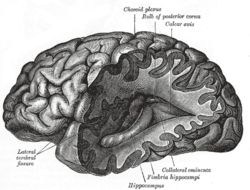Cranial electrotherapy stimulation
Cranial electrotherapy stimulation (CES) is a form of non-invasive brain stimulation that applies a small, pulsed electric current across a patient's head to treat anxiety, depression, insomnia and chronic pain.[1]
CES technology has been regulated by the U.S. Food and Drug Administration (FDA) since 1977[2] and is classified as Class III "for devices that have insufficient information or are life-supporting, life-sustaining, or present an unreasonable risk for illness or injury".[1]
Effectiveness
There is insufficient data to support CES in treatment of depression.[3] There are no controlled studies for affective disorders.[4] A 1995 meta-analysis of CES for the treatment of anxiety found it better than "sham", but noted that 86% of the studies included in the review were inadequately blinded and the experimenter "knew which patients were receiving CES or sham treatment". Most studies cited as evidence for the effectiveness of CES failed to report all data necessary for meta-analysis.[5]
Regulation
In the United States, CES technology is classified by the Food and Drug Administration as a Class III medical device and must be dispensed by or on the order of a licensed healthcare practitioners, i.e., a physician, psychiatrist or nurse practitioner; psychologist, physician assistant, or occupational therapist who has an appropriate electrotherapy license, dependent upon state regulations.[6][7]
According to Rosa and Lisanby (2012), CES "became FDA sanctioned for the treatment of depression, anxiety, and insomnia" but "was never subjected to the level of regulatory review now required for new technologies because it was 'grandfather-ed' based on a device that predated the current FDA regulations ... however, there is a relative lack of controlled clinical trials supporting its efficacy."[4]
Some CES devices are also approved by Health Canada and have CE/ISO marks.[8]
Proposed mechanism of action
The exact mechanism of action of CES is unclear.[4]
History
"Electrotherapy" has been in use for at least 2000 years, as shown by the clinical literature of the early Roman physician, Scribonius Largus, who wrote in the Compositiones Medicae of 46 AD that his patients should stand on a live black torpedo fish for the relief of a variety of medical conditions, including gout and headaches. Claudius Galen (131 - 201 AD) also recommended using the shocks from the electrical fish for medical therapies.[9]
Low intensity electrical stimulation is believed to have originated in the studies of galvanic currents in humans and animals as conducted by Giovanni Aldini, Alessandro Volta and others in the 18th century. Aldini had experimented with galvanic head current as early as 1794 (upon himself) and reported the successful treatment of patients suffering from melancholia using direct low-intensity currents in 1804.[10]
Modern research into low intensity electrical stimulation of the brain was begun by Leduc and Rouxeau in France (1902).[11][12][13] In 1949, the Soviet Union expanded research of CES to include the treatment of anxiety as well as sleeping disorders.[14]
In the 1960s and 1970s, it was common for physicians and researchers to place electrodes on the eyes, thinking that any other electrode site would not be able to penetrate the cranium.
CES was initially studied for insomnia and called electrosleep therapy;[15] it is also known as cranial-electro stimulation[16] and transcranial electrotherapy.[17]
See also
- Transcranial direct current stimulation
- Transcranial magnetic stimulation
References
- ↑ 1.0 1.1 Shelley A (February 17, 2012). "Electrical Stimulators Need High-Risk Rating, Says FDA Panel". Medscape Medical News. Retrieved February 21, 2015.
- ↑ FDA Executive Summary for February 10, 2012 Neurologic Devices Panel, fda.gov
- ↑ Kavirajan HC, Lueck K, Chuang K (2014). "Alternating current cranial electrotherapy stimulation (CES) for depression". Cochrane Database Syst Rev 7: CD010521. doi:10.1002/14651858.CD010521.pub2. PMID 25000907.
- ↑ 4.0 4.1 4.2 Rosa MA, Lisanby SH (2012). "Somatic treatments for mood disorders". Neuropsychopharmacology 37 (1): 102–16. doi:10.1038/npp.2011.225. PMC 3238088. PMID 21976043.
- ↑ Sidney Klawansky (July 1995). "Meta-Analysis of Randomized Controlled Trials of Cranial Electrostimulation: Efficacy in Treating Selected Psychological and Physiological Conditions". Journal of Nervous & Mental Disease 183 (7): 478–484. doi:10.1097/00005053-199507000-00010.
- ↑ 21CFR882.5800, Part 882 ("Neurological Devices")
- ↑ FDA Panel Votes to Curtail Cranial Electrotherapy Stimulators, Psychiatric Times
- ↑ Health Canada Approves Drug-Free Treatment Fisher Wallace Stimulator® for Insomnia and Chronic Pain, Yahoo Finance
- ↑ Stillings D. A Survey Of The History Of Electrical Stimulation For Pain To 1900 Med.Instrum 9: 255-259 1975
- ↑ Soroush Zaghi, Mariana Acar, Brittney Hultgren, Paulo S. Boggio, and Felipe Fregni. "Noninvasive Brain Stimulation with Low-Intensity Electrical Currents: Putative Mechanisms of Action for Direct and Alternating Current Stimulation." Neuroscientist. 2010 Jun;16(3):285-307 doi:10.1177/1073858409336227
- ↑ Leduc S. La narcose electrique. Ztschr. fur Electrother., 1903, XI, 1: 374-381, 403-410.
- ↑ Leduc S., Rouxeau A. Influence du rythme et de la period sur la production de l'inhibition par les courants intermittents de basse tension. C.R. Seances Soc.Biol., 1903,55, VII-X : 899-901
- ↑ L.A. Geddes (1965). Electronarcosis. Med.Electron.biol.Engng. Vol.3, pp. 11–26. Pergamon Press
- ↑ Гиляровский В.А., Ливенцев Н.М., Сегаль Ю.Е., Кириллова З.А. Электросон (клинико-физиологическое исследование). М., "Медгиз", 2 изд. М., "Медгиз", 1958, 166 с.
- ↑ Appel, C. P. (1972). Effect of electrosleep: Review of research. Goteborg Psychology Report, 2, 1-24
- ↑ Iwanovsky, A., & Dodge, C. H. (1968). Electrosleep and electroanesthesia–theory and clinical experience. Foreign Science Bulletin, 4 (2), 1-64
- ↑ Gibson TH, Donald E. O'Hair. Cranial application of low level transcranial electrotherapy vs. relaxation instruction in anxious patients. American Journal of Electromedicine. 1987;4(1):18-21
Further reading
- Guleyupoglu B, Schestatsky P, Edwards D, Fregni F, Bikson M (2013). "Classification of methods in transcranial electrical stimulation (tES) and evolving strategy from historical approaches to contemporary innovations". J. Neurosci. Methods 219 (2): 297–311. doi:10.1016/j.jneumeth.2013.07.016. PMC 3833074. PMID 23954780.
| ||||||||||||||||||||||
